Beef Focus Farm: Diet and EBVs help farmers hit the target
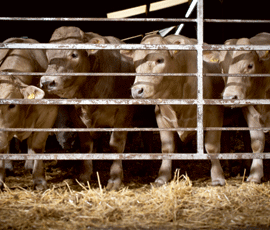
Running a herd of small- to medium-sized, milky, beef-sired, dairy-bred suckler cows put to high index, easy calving, fast growing terminal sires – that’s the blueprint for profitable suckled calf production.
It’s a view shared by Peak District suckled calf producer Simon Frost – Farmers Weekly’s Beef Focus farmer – and Harper Adams University’s beef specialist Simon Marsh.
Mr Marsh says the very high DLWGs being achieved by calves produced at Simon Frost’s Hopping Farm Youlgrave, Derbyshire, are not a result of “calves being stuffed with creep feed.”
“The feed is only introduced to bulls in early August followed by the heifers a few weeks later. It’s fed to a maximum of 1.5kg a calf a day and is a 16% protein high NDF nut. The aim is to grow frame rather than put on flesh,” says Mr Marsh.
But he believes that feeding creep is essential. “Not only does it improve rumen development, but it’s also extremely efficient. Calves can convert creep at a rate (FCR) of 3.5:1 – but most importantly it helps minimise the growth check at weaning.”
At weaning in mid-October calves are sold to Alan and John Dore at Glapwell, Chesterfield, and intensively finished.
“The Dore brothers recognise the importance of knowing the calves from Simon Frost are sired by high index bulls with exceptional growth potential,” says Mr Marsh.
“The question I would ask store cattle buyers at this time of year is how much do they know about the calves they’re buying?
“When they buy a tractor they get a full breakdown of the spec of the machine, but they don’t buy store cattle with the same philosophy. A lot of money is spent on store cattle and while buyers know what they look like, that’s about all. They’ve no knowledge of what’s going on inside the engine.”
The performance results from Mr Frost’s 56 Charolais-sired bulls born in 2010 (Table 1) have been benchmarked against EBLEX targets. They achieved an impressive carcass weight of 427kg at 415 days (just over 13.5 months old).
“They smashed the EBLEX targets. A tremendous performance,” says Simon Marsh.
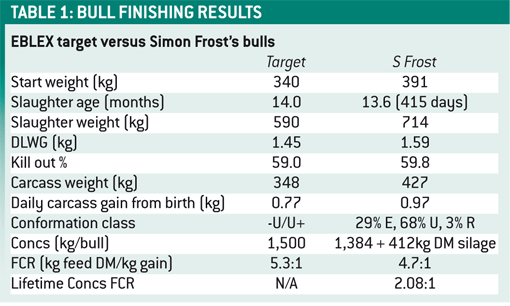
Heifer finishing results
Coping with the early maturity and lower finishing weights of intensively finished heifers is a constant challenge, says Mr Frost.
“They’re more easily fleshed and finish at significantly lower slaughter weights than bulls. So the Dore brothers feed heifers top quality (11.6 ME, 50.6% DM, 13.6% CP) big bale grass silage – but with less home-mix feed.
“The heifer ration is 16% CP and based on rolled barley with some oats – to take the heat out of the mix, lower the starch content and provide some fibre – quality protein from hipro soya plus linseed flakes and minerals.
“It’s a top-quality diet to match the high genetic merit of these cattle and help them achieve above average DLWGs,” explains Mr Marsh.
Heifers are fed a fixed 3.1kg a head a day in two feeds, with ad lib access to silage. From five weeks before slaughter the home-mix is increased to 5.7kg to accelerate daily gain and achieve adequate fat cover to target Fat Class 4L.
The average UK carcass weight for all heifers is 322kg with a slaughter age of 712 days (23.3 months). Simon Frost’s heifers achieved a mean carcass weight of 313kg at just 447 days.
Compared to the UK average these heifers were finished 265 days (8.7 months) – clearly helping to reduce their carbon foot print. See Table 2 for full breakdown.
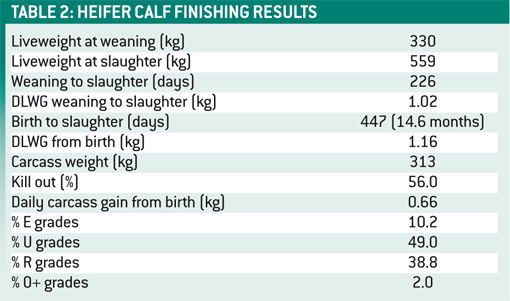
The heifers killed out – gut full – at 56.0%. That’s a live slaughter weight of 559kg achieved from a DLWG from weaning to slaughter of 1.02kg and a birth to slaughter DLWG of 1.16kg.
The daily carcass gain – a figure Mr Marsh believes should be considered more widely as a measure of performance – was 0.66kg and was calculated by removing 20kg as the birth carcass weight, which is industry practice.
There were 32.7% of heifers grading at fat class 3 and 53.1% at fat class 4L – both are the desired levels of fat cover for most markets. Only 10.2% of the heifers graded 4H – a fat cover level which isn’t usually penalised by markets unless it’s an O+ or worse for conformation.
Feed use and FCRs
As shown in Table 3 the heifers converted feed at a FCR of 6.59(kg DM):1. But since 51% of their feed requirement was supplied by grass silage, the concentrate FCR during the finishing phase was just 3.75:1.
If the FCR is calculated based on lifetime concentrate intake – including 70kg of creep feed – it equates to a lifetime concentrate FCR of 1.79.1 – a figure that’s better than finishing pigs and similar to broiler chickens.
If the FCR is calculated based on kg of feed dry matter a kg carcase gain, then it’s 3.17:1.
Mr Marsh says: “I acknowledge the calves were also fed cow’s milk, grass and silage but the latter two can’t be used by humans; it’s a different angle to consider when beef production is considered to be inefficient when compared to pig and poultry meat production.”
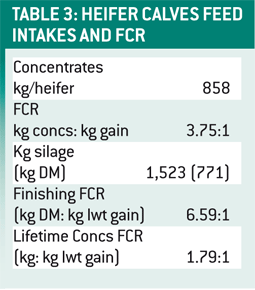
Compared to the bulls, Simon Frost’s heifers were slaughtered slightly later and at significantly lower carcass weights. Based on current prices the bull carcasses are worth an extra £336 per head. But while they consumed an extra 526kg of concentrates (worth £92) they ate 359kg DM less silage worth £31.
But if the heifers’ extra 23 days taken to reach slaughter condition is costed at 40p/day (variable costs including straw) it shows the bulls grossed £314 more than the heifers.
High versus Low Fat Depth EBVs
Mr Frost believes it’s important to focus on the EBV for Fat Depth. He targets a Fat Depth EBV of minus 1mm compared to the breed average of minus 0.3mm.
“By using bulls with a large negative Fat Depth EBV, calves grow to heavier slaughter weights without laying down excessive fat – and that’s important for heifers.
“But a large negative Fat Depth EBV isn’t a desirable trait for producers selecting bulls to breed herd replacements. Using a bull in this situation with a low or even positive Fat Depth EBV is important because the heifers, when kept as suckler cows, will more readily put on body condition. And that’s vitally important for fertility and for mobilising body condition over the winter and so reducing feed costs.
“The British Charolais Cattle Society has now changed its position on the Fat Depth EBV and view negative scores as a negative or undesirable trait.”
The heifer calf finishing results have been analysed for the progeny of two Charolais sires – Hookcarr Arney (Terminal Index +55 – a top 1% bull) and Balthayock Clifford (TI +62).
Arney has a Fat Depth EBV of 0.0mm (compared to the breed average of -0.3mm) and Clifford has a negative Fat Depth EBV of -1.0mm. Both bulls have identical 400 day weight EBVs of +60kg compared to the breed average of +38kg.
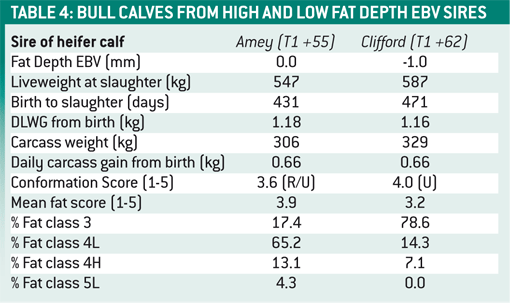
Mr Frost says: “The data in Table 4 clearly illustrate the value of EBVs. They show Clifford calves recorded carcase weights 23kg heavier, but more importantly fat class scores were significantly lower – 92.9% grading in the target 3 and 4L category.
“With a base price of £3.25/kg for an R grade carcass – with standard premiums for improved conformation and deductions for over-fat carcasses – this makes the Clifford calves worth about £92 more a head.
“After the deduction of extra feed and variable costs, to reach slaughter condition they still left a higher margin worth £63 per heifer. More importantly, the carcasses produced were at the required weights and grades for most outlets.
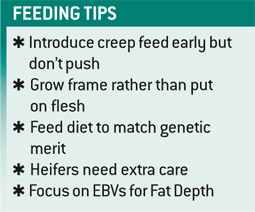
More on the Harper Adams Beef Focus Farm – HABFF
